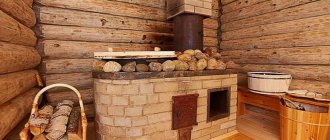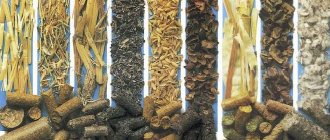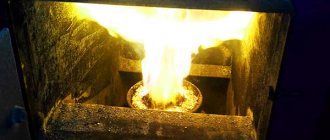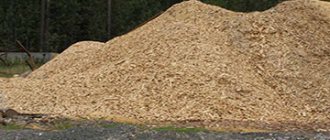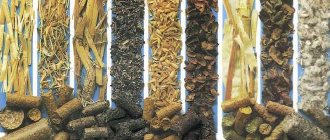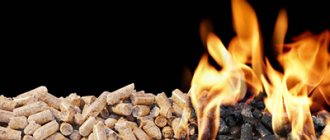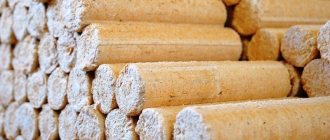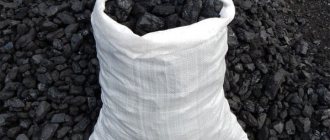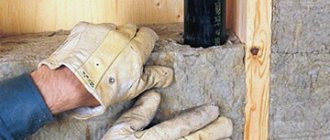Pellet boilers are convenient because they can operate autonomously for a long time. For uninterrupted operation, they only need a guaranteed and uniform supply of fuel. Bunkers are used to store and supply pellets. They come in two types: built into the boiler and free-standing, they are also called “external” or “external”.
Built-in ones are located in the boiler. Their disadvantage is their small volume and, therefore, short operating time without additional fuel loading. The advantage is that there is no need to think about where to place or where to make a bunker.
The built-in pellet hopper has a small volume
Types of bunkers
Essentially, a bunker is a room where fuel is loaded and automatically supplied directly to the boiler.
At the same time, the bunker and boiler must meet many requirements - and, first of all, fire safety rules.
Depending on its characteristics, a pellet bunker is capable of supplying pellets for heating homes and industrial enterprises: from one week to an entire heating season. When choosing a storage facility, consider the boiler parameters.
Stores offer several types of pellet bins:
- Standing alone . The simplest way out of the situation, but not the worst in terms of performance. This type of bunker can operate from several hours to several days, if the volume of loaded pellets allows it.
- Additional bunker . Can increase the life of the boiler to a couple of months. Some time ago, plastic bins appeared on the market.
- A room with a V-shaped floor with slopes . It is a popular way to increase boiler productivity, because. Instead of one bunker, a whole room is used, which you can equip yourself or involve specialists. Benefits include simplicity, increased automation and reduced energy costs for feeding pellets. The disadvantage is the fact of space deprivation: approximately 20% of the storage volume. In most cases, special hatches or a twin-screw transmission are used to load pellets. Fuel is placed throughout the entire area of the room using augers; it is also possible to use a vacuum pump.
- Underground storage . The most difficult storage to implement. The bunker should be located at the same level as the boiler room: in the basement. All this leads to the need for careful calculations, smart design and selection of a suitable location.
However, despite all the difficulties, an underground bunker has some advantages:
- firstly, ease of loading: it is carried out through a hatch opening to the surface;
- secondly, the underground bunker is located at some distance from the building and is not closely adjacent, which increases fire safety and prevents sudden fire. A vacuum pump or augers are used to feed pellets into the boiler.
How to do
Making containers yourself is not particularly difficult. You can make a frame from a metal corner, cover it with boards, plywood, weld metal of the appropriate shape to the corner, etc. What you need to pay attention to when developing the design is that most bins have at least one inclined wall, which guarantees uniform pouring of granules. There may be more difficulties with a screw device, but you can always buy a ready-made one. It will still be cheaper than buying a branded one. For example, a MAFA Mini bunker with a volume of 300 liters costs 500 euros, a bunker from the same company, but with a volume of 750 liters costs 900 euros.
It’s easy to make a pellet hopper yourself
To manufacture a screw device, you need: a screw of the required length and diameter of 75-100 mm (2), a metal pipe of a larger diameter than the screw (1), a motor that is controlled from the burner (3). We insert the auger inside the pipe, connect the motor, and insert the pipe into the hole in the lower part of the pellet hopper.
Screw device
There are no particular difficulties foreseen in the manufacture of a pellet bunker. No special technique or any supernatural abilities are needed here. Sometimes the so-called “locking” effect occurs when the pellets “hang” at a certain height. The problem is solved with a “tedder”: a small-diameter pipe to which not very long pieces of wire are welded. This “tedder” is connected to a separate motor.
Pellet hopper with tedder
If desired, the presence/absence of pellets in the bunker can be monitored with special sensors. But this capability is usually implemented in large volume silos that are rarely visited and inspected. What types of pellets are there, what is their difference, read the article Pellets for heating: types and features of use.
Fire safety rules
Since the bunker is designed to store fuel, which is highly flammable, you must follow simple rules to minimize the risk of fire:
- loading the room to the top;
- ventilation before filling the bunker;
- stopping the boiler an hour before filling the bunker with fuel;
- installation of an independent fire extinguishing system for industrial enterprises;
- frequent cleaning and cleaning of mechanical elements and grounding of metal parts;
- installation of a sluice gate between the pellet bunker and the boiler room;
- equipping the mechanics with sensors that stop work when the screws heat up from 85 to 95 degrees.
Why a burner?
Pellets can be loaded into a regular stove and set on fire, they will burn. They will also burn in a stove or long-burning boiler. But the ash content will be at best 20%, and maybe even 60% (!). Therefore, when burning pellets, preliminary pyrolysis of the fuel mass is widely used; in this case, the ash content will be 2-5%. But there is no point in loading pellets into a pyrolysis furnace or boiler: in a device that burns pyrolysis gases in a separate chamber, they will coke, sinter, and there will be even more fuel waste, plus unscheduled cleaning and/or repair of the boiler. Therefore, pellets are burned in special burners, where the zones of pyrolysis and formation of a torch of burning gases partially overlap. The design of the burner is, in principle, simple. How to make a simple pellet burner, see for example. video:
Video: a simple homemade pellet burner
However, for a more or less technically literate person, an obvious question will arise: the temperature of the torch flame reaches 1000 degrees or more. How long will ordinary structural steel last in direct contact with it? There are other, no less important nuances, so it’s too early to install a simple pellet burner in your home boiler. By the way, you can get burned, see below. First you need to figure out how to properly make a pellet burner, suitable at least as a spare, in case of shortage or unavailability of the main fuel.
Is it worth it?
Economically, independent production of a spare pellet burner makes complete sense, because prices for fairly reliable branded products start around $500, if we are talking about a semi-automatic burner that requires daily maintenance; This one will be suitable as a spare. And for an automated set of equipment for heating with pellets, which requires a trip to it once a week to reload fuel, you will have to pay $3,000 or more.
Distance between boiler and pellet storage
Fire regulations and manufacturers' advice also establish the correct relative position of the pellet bunker and the boiler.
In particular, they make such demands.
- The underground warehouse must be no closer than 1 m from the wall of the room where the boiler is located.
- The storage room and boiler room are enclosed by a fire-resistant brick partition.
- The bunker should not be located further than 12 m, since as the distance between the boiler and storage increases, the risk of pellet deformation increases, which leads to the formation of wood dust, which reduces the performance of the boiler.
PELLET SET
Wirbel Cm Pellet-set (Pellet equipment) is a set of equipment for installation on new or existing Wirbel boilers of the ECO CK (CK PLUS) and ECO CKB (CKB PLUS) models with a power from 20 to 90 kW. The components of the Cm Pellet-set are constructed in accordance with modern technology and design, made from properly tested, high-quality materials. When installing Pellet-set equipment, you get a fully automatic pellet boiler, with the exception of loading fuel into the hopper. In terms of operation and level of comfort, the “Wirbel CK (CK PLUS) solid fuel boiler + Pellet Set” set is in no way inferior to a boiler set with a gas or diesel burner, while in terms of fuel costs it is up to 40% more economical than systems running on diesel fuel . Assembly and commissioning of Wirbel Cm Pellet-set is carried out by an authorized technician.
The Wirbel Cm Pellet Set (pellet burning equipment) includes:
- Pellet burner CPPL 20-35, 40-50 and 70-90 kW made of high quality and reliable materials. Inside the burner there is a heavy-duty fan, which, with the help of a specially designed grille, supplies the fire like any other classic burner. In addition to the fan, there is a heating element inside the burner, which, using an adjustment system, automatically ignites the pellets according to needs. A photocell for detecting the presence of fire is built into the burner. The special shape of the burner combustion chamber ensures good mixing of air and fuel, which leads to an efficient combustion process. Depending on the phase of burner operation, the fan speed is also adjusted. The burner is attached to the included lower door with a special hole.
- The bottom door of the DPDV boiler comes complete with the Wirbel Cm Pellet-set and has a special hole adapted for connecting a burner. The standard boiler door is removed and a new DPDV is installed in its place, to which a CPPL pellet burner is connected.
- The sophisticated digital control panel CPREG controls the boiler according to heat and hot water needs. Microprocessor control, bimetallic safety thermostat, emergency pressure sensor. The remote control lights up and extinguishes the burner in accordance with the set temperature and operating modes, regulates the flow of pellets through the auger and operates in accordance with summer and winter modes. The display shows the boiler operating parameters. There are switches for starting the boiler and hot water.
- Pellets are fed from the hopper to the burner via a CPPT screw. Pellets are fed using an electric motor and gearbox from the hopper to the burner by means of a spiral through a flexible hose. The electric motor has all the wires and can be easily connected to the connector on the back of the control panel.
- The CPSP pellet hopper can be located to the right or left of the boiler. After installing the hopper, the auger should be connected. Before loading the hopper, the door located at the top of the hopper must be open, and it is necessary to check whether there are any solid objects or other materials inside to prevent damage to the equipment.
Instructions and documentation for Wirbel Pellet SET:
- Description of Wirbel Pellet-Set
- Technical manual Pellet-Set 14-35
- Technical manual Pellet-Set 40-50
- Pellet-Set Certificate
- Technical manual for the bunker
- Technical manual for the conveyor (pellet feed auger)
Systems for feeding pellets from storage to the boiler
The connection of the external bunker to the wood pellet boiler is carried out by means of a screw (worm) and vacuum fuel transmission. When choosing a connection option, pay attention to several characteristics:
- Energy consumption.
- Noise characteristics.
- Dependence on constant availability of electricity.
By paying attention to the points listed above, you can choose the best option for a private home or industrial premises.
Auger transportation of pellets
A storage hopper with an auger is quite difficult to integrate into existing premises. The use of a worm gear reduces the usable storage area by almost 20%.
Vacuum feeding of wood pellets
Vacuum transportation of pellets from the storage warehouse to the heating boiler bunker is more convenient and efficient. The length of the transport route increases to 30 m, 10 m more than the permissible limit of the screw drive. There are many options for placing storage on the site near the house. It is possible to simultaneously connect several containers at once or increase an existing bunker to 30 m³.
PPB requirements for pellet storage facilities
The boiler room and pellet storage are potentially dangerous premises with a high probability of fire. It is imperative to take preventive measures to prevent a fire from occurring.
